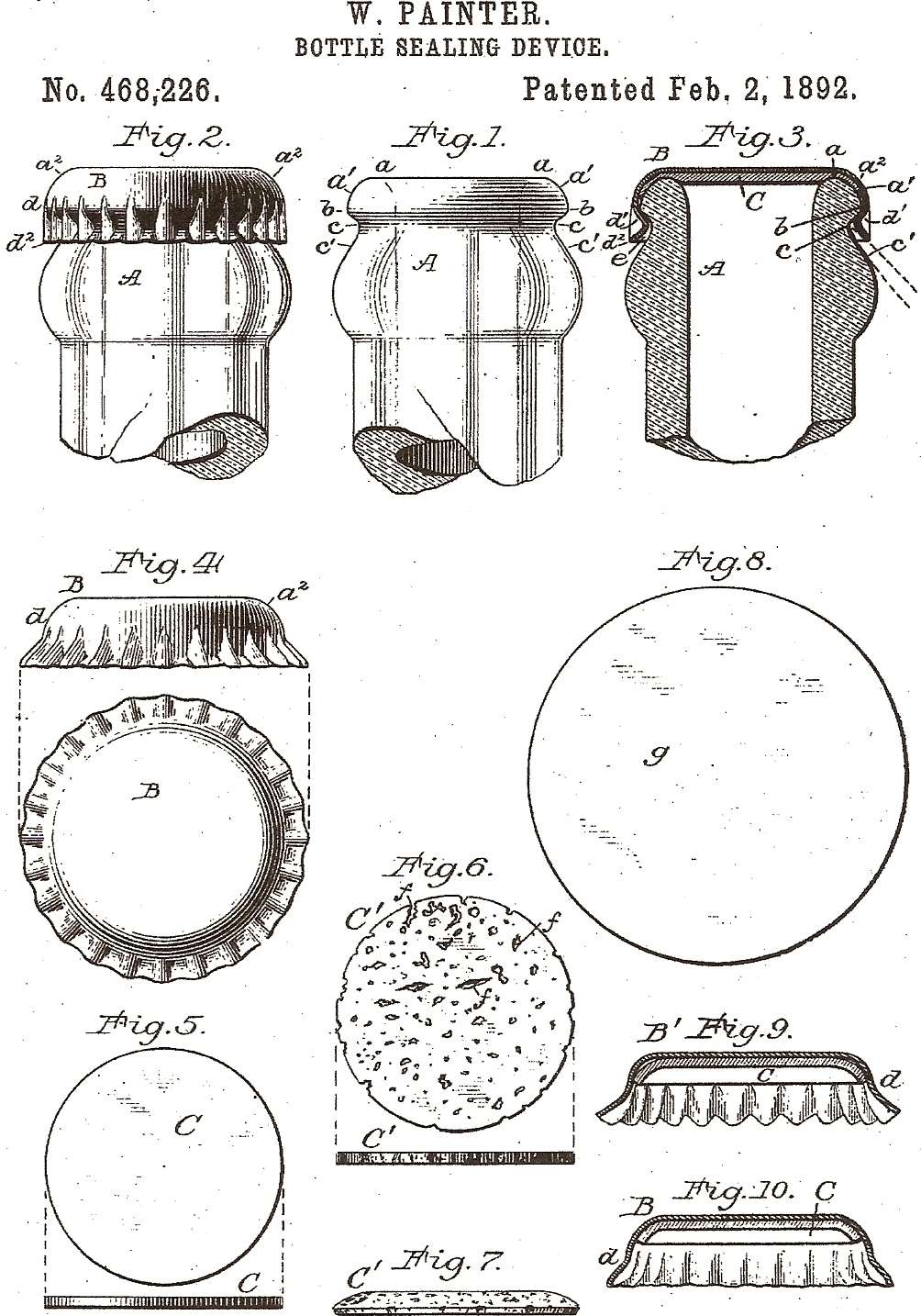William Painter Bottle Stopper

William
Painter filed separate “Bottle Sealing Device” patent applications
November 5, 1889 (renewed October 6, 1891), June 16, 1890, and May 19,
1891. All three patents were
granted February 2, 1892.
Painter’s highly-detailed drawings and patent specifications clearly
illustrate and explain the evolutionary development of his “Crown Cork”
system. The illustrations
shown above accompanied Patent No. 468,226 (the 1891 filing) and
specified:
I, William Painter, of Baltimore…Maryland, have
invented certain new and useful Improvements in Bottle-Sealing
Devices…(pertaining to) the sealing of bottles by the use of
compressible packing-disks and metallic caps, which have flanges bent
into reliable locking engagement with annular locking-shoulders on the
heads of bottles, while the packing-disk is in each case under heavy
compression and in enveloping contact with the lip of the bottle.
In order that the status of my present improvements
may be properly defined with respect of novelty and utility, I deem it
proper to briefly review the prior art in this special connection.
So far as my knowledge extends, I am the first to seal bottles by
means of sealing-disks each compressed into close solid contact with the
lip of the bottle and maintained in that condition by means of a flanged
metallic sealing-cap, the flange of which is bent or crimped into
locking contact (while the disk is under pressure) with an appropriate
annular locking-shoulder on the head of the bottle, as well as the first
to devise methods and means by which in the use of such caps and disks
liquids can be bottled under even the highest gaseous pressures employed
in this art…
Considerable manual force must be applied for
detaching the caps from the bottles, and therefore in the early stages
of my invention the use of loops of some kind or of equivalent holes in
the tops of the caps was deemed essential, and the caps had wide or deep
pendent flanges and they contained sealing-disks of considerable bulk or
thickness…Contingencies led, after much devising and experimenting, to
the production of a cap without a loop or hole in its top, a thinner
disk, and consequently narrower flanges, thus substantially reducing the
cost of the sealing device as a whole without decreasing, but in fact
increasing, the efficiency of the applied cap, and also securing higher
sealing efficiency by the use of a less expensive disk…
These improved caps having in themselves no special
provision – such as loops or openings in their tops – for detaching them
from bottles led to my further devising a novel method of their
combination with the bottle, in accordance with which the pendent edge
of the flange below the bent portion is so far projected from the
adjacent surface of the bottle-head as to afford an engaging-shoulder,
to which a bottle-opener could be readily applied…The disadvantages to
consumers incident to a positive requirement for the use of
specially-constructed openers are obvious, and to avoid them I have now
so devised my loopless and close-topped caps and have so organized a
combination thereof with the bottles that the cans can be almost as
readily detached by the use of a knife, a screw-driver, a nail, an
ice-pick, or any usually and readily available pointed instrument…
Referring to the drawings, Figure 1, in side view,
illustrates a bottle-head adapted for use in combination with my cap and
a sealing-disk. Figs. 2 and
3 respectively illustrate in side view and section a bottle-head with
one of my caps and a sealing-disk applied thereto.
Fig. 4, in side and top views, illustrates a cap prior to its
application to a bottle.
Fig. 5, in top and edge views, illustrates a sealing-disk of a composite
character in its normal form.
Fig. 6, in top and edge views, illustrates a sealing-disk in its
normal condition composed of ordinary cork and fairly indicating the
open or porous character of such disks as have been successfully used by
me with my caps in maintaining gas or air tight closure even under much
higher pressures than are ever needed in bottling.
Fig. 7 illustrates a cork disk in the form which is made to
assume within the cap and after it has been subjected to heavy pressure
for reducing its hard spots.
Figs. 8, 9, and 10 respectively illustrate a sheet-metal blank from
which the cap is formed, the shape first developed therefrom and the
final shape, these being in section with the sealing-disks therein.
Comments:
William Painter’s patent specifications provide
detailed insight into the numerous challenges he encountered and
successfully overcame while designing caps, seals, the bottle head’s
contoured lip, etc. The
complete patent specifications are fascinating, but aren’t the focus of
this review and therefore were not included in their entirety.
Painter's highly successful Crown Cork seal capped off (pun
intended) the broad range of bottle stopper patents that triggered the
curtain to fall on the
 HutchBook.com
HutchBook.com